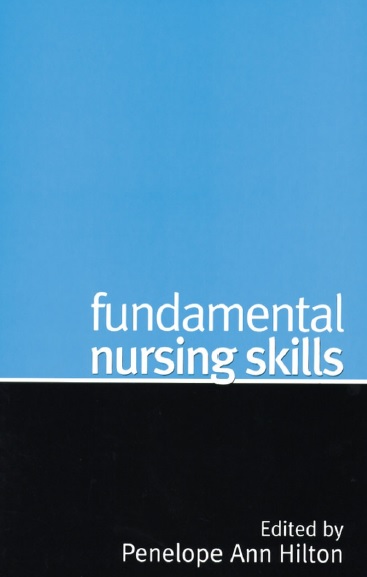Contents
Acknowledgements xi
Preface xiii
Contributors xv
Introduction xvii
Chapter 1 Breathing
Penelope Ann Hilton 1
Introduction
Common terminology
Assessing an individual’s ability to breathe
Monitoring respiratory rate
Monitoring peak flow
Maintenance of an airway
Monitoring expectorant
Disposal of sputum/oral secretions
Obtaining a sputum specimen
Administration of oxygen
Artificial respiration (rescue breathing)
References and further reading
Chapter 2 Mobilizing
Samantha Athorn and Penelope Ann Hilton 20
Introduction
Common terminology
Assessing an individual’s ability to mobilize
Moving and handling
Care of an individual who is falling
Care of an individual who has fallen
References and further reading
Chapter 3 Personal cleansing and dressing
Alyson Hoyles, Penelope Ann Hilton
and Neal Seymour 43
Introduction
Common terminology
The skin
Assessing an individual’s ability to cleanse and dress
Making a bed or cot
Changing linen on an occupied bed or cot
Disposal of linen
Assisting individuals with bathing
Assisting individuals with oral hygiene
Assisting individuals with eye care
Facial shaving
Hair care
Assisting individuals to dress
References and further reading
Chapter 4 Maintaining a safe environment
Julie Foster and Penelope Ann Hilton 75
Introduction
Common terminology
Personal safety
Principles of health and safety at work
Universal precautions
Principles of asepsis
Monitoring a client’s pulse
Monitoring blood pressure
Responding in the event of a cardiopulmonary arrest
Administration of medicines
Responding in the event of a fire
Assessing an individual’s ability to maintain
a safe environment
References and further reading
Chapter 5 Eating and drinking
Catherine Waskett 128
Introduction
Common terminology
Assessing an individual’s nutritional status
vi Fundamental Nursing Skills
Assessing an individual’s hydration status
Assisting clients in selecting appropriate meals/fluids
Monitoring nutritional status
Monitoring fluid intake
Assisting with eating and drinking
Feeding dependent clients and clients with
potential swallowing difficulties
Providing first aid to a client who is choking
References and further reading
Chapter 6 Communicating
Penelope Ann Hilton and Helen Taylor 159
Introduction
Common terminology
Assessing the communication needs of clients
Responding to telephone calls
Communicating with clients
Managing violence and aggression
Record keeping
References and further reading
Chapter 7 Dying
Penelope Ann Hilton 178
Introduction
Common terminology
Assessing the dying client
Communicating with dying clients and their relatives
Signs of approaching death
Confirming death
Accounting for valuables
Last Offices
References and further reading
Chapter 8 Eliminating
Carol Pollard and Beverly Levy 199
Introduction
Common terminology
Assessing the individual’s ability to eliminate
Assisting clients to use toileting facilities
Applying/changing a nappy
Care of an indwelling urinary catheter
vii Contents
Monitoring urinary output
Monitoring bowel actions
Monitoring vomitus
References and further reading
Chapter 9 Maintaining body temperature
Sheila Lees and Penelope Ann Hilton 225
Introduction
Common terminology
Normal body temperature
Methods of temperature measurement
Assessing an individual’s ability to maintain
body temperature
Monitoring temperature
Recording and documenting body temperature
Strategies to raise or lower body temperature
References and further reading
Chapter 10 Expressing sexuality
Penelope Ann Hilton 239
Introduction
Common terminology
Assessing an individual’s ability to express sexuality
Maintaining privacy and dignity
Assisting individuals to express sexuality
References and further reading
Chapter 11 Working and playing
Samantha Athorn and Penelope Ann Hilton 253
Introduction
Common terminology
Assessing an individual’s ability to work and play
Assisting individuals to select appropriate
work activities
Assisting individuals to select appropriate
recreational activities
References and further reading
viii Fundamental Nursing Skills
Chapter 12 Sleeping
Penelope Ann Hilton 267
Introduction
Common terminology
Assessing an individual’s needs in relation
to sleep and rest
Monitoring an individual’s sleep and rest patterns
Assisting individuals to achieve a balance
between activity and rest
References and further reading
Appendix I Rapid reference aids
Penelope Ann Hilton 277
Introduction
NMC Code of Professional Conduct
Guide to interpreting common medical
and surgical terminology
Glossary of medical and surgical terms
Common medical and nursing abbreviations
Common prescribing abbreviations
Conversion tables
Child development chart
Body mass index
Laboratory values
Calculating infusion (drip) rates
Calculating medications
Appendix II Record of achievement
Penelope Ann Hilton 306
Guidelines on the use of this record of achievement
Skills related to the activity of breathing
Skills related to the activity of mobility
Skills related to the activity of personal
cleansing and dressing
Skills related to the activity of maintaining a safe
environment
Skills related to the activity of eating and drinking
Skills related to the activity of communicating
Skills related to the activity of dying
Skills related to the activity of eliminating
ix Contents
Skills related to the activity of maintaining body
temperature
Skills related to the activity of expressing sexuality
Skills related to the activity of working and playing
Skills related to the activity of sleep and rest
Additional skills
